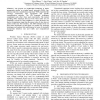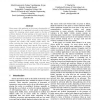380 search results - page 25 / 76 » A framework for multi-robot node coverage in sensor networks |
INFOCOM
2003
IEEE
14 years 25 days ago
2003
IEEE
— We propose a general framework for broadcasting in ad hoc networks through self-pruning. The approach is based on selecting a small subset of hosts (also called nodes) to form ...
INFOCOM
2008
IEEE
14 years 1 months ago
2008
IEEE
—Due to adverse aqueous environments, non-negligible node mobility and large network scale, localization for large-scale mobile underwater sensor networks is very challenging. In...
HYBRID
2007
Springer
13 years 11 months ago
2007
Springer
We show how Embedded Graph Grammars (EGGs) are used to specify local interaction rules between mobile robots in a natural manner. This formalism allows us to treat local network to...
ICC
2007
IEEE
14 years 1 months ago
2007
IEEE
— We propose two lightweight techniques to detect masquerade attacks on wireless sensor networks (WSN). Our solutions take into consideration, important WSN properties like cover...
DSN
2005
IEEE
14 years 1 months ago
2005
IEEE
Since sensor data gathering is the primary functionality of sensor networks, it is important to provide a fault tolerant method for reasoning about sensed events in the face of ar...


